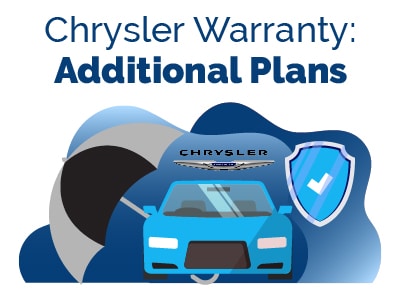Chrysler Warranty Coverage Guide [Factory & Extended Warranty]
July 11, 2022
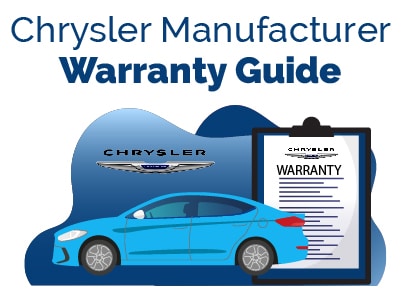

I am a serial entrepreneur and a consumer advocate. When I’m not helping car buyers, I love working on ventures that have a positive impact.
I run a cause marketing agency and serve on the board of Vayu Global Health where we are disrupting the medical industry and preventing the needless deaths of mothers and babies during childbirth.
Nobody likes reading through the fine print of contracts, so we’ve done the tedious bit for you.
We’ve highlighted all the important information related to Chrysler's factory and extended warranty programs.
There are many types of warranties to consider, including Chrysler's own warranty, which is provided by Mopar, and third-party providers. We’ll break down and compare to see which extended warranty option is right for you.
Table of Contents
- What Is the Standard Chrysler Factory Warranty?
- What Do You Do When Your Chrysler Car Warranty Expires?
- What Is the Chrysler Extended Warranty?
- Chrysler Additional Protection Plans
- Chrysler Warranty Additional Benefits
- Protect Your Chrysler Lease
- How Much Does Chrysler Extended Warranty Cost?
- What Is Not Covered by Chrysler Extended Warranty?
- Should I Get the Chrysler Extended Warranty?
- Chrysler Extended Warranty vs. Third-Party Extended Warranty
- Can I Cancel Chrysler Warranty?
- Chrysler Maintenance Guide
- Best Car Deals by Category
- Frequently Asked Questions
What Is the Standard Chrysler Factory Warranty?
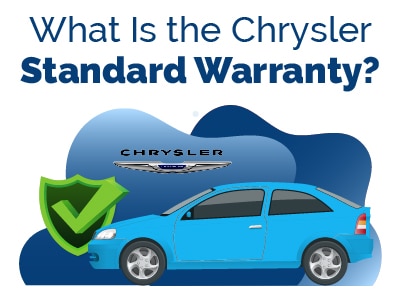
Here’s a breakdown of the factory coverage Chrysler offers:
Bumper-to-Bumper Limited Warranty
Also known as the basic limited warranty, this warranty provides bumper-to-bumper coverage for thousands of Chrysler components. It has a small list of exclusions to note. This warranty lasts for 3 years/36,000 miles, with certain components receiving coverage for only 1 year/12,000 miles.
Powertrain Limited Warranty
The Powertrain Limited Warranty lasts for 5 years or up to 60,000 miles. It covers the transmission, engine, torque converter, drivetrain, drive system, and other critical parts.
Emission Control System Limited Warranty
This warranty protects components that reduce emissions, and it’s required by law. Coverage lasts for 2 years/24,000 miles.
Electric & Hybrid Warranty
This warranty covers parts unique to electric and hybrid vehicles, like the battery. Coverage lasts for 10 years or up to 150,000 miles.
CPO Warranty
Certified Pre-Owned Chrysler’s also include factory warranties. It comes with a 7-year/100,000-mile Powertrain Limited Warranty as well as a 3-month/3,000-mile maximum car warranty similar to bumper-to-bumper coverage.
What Do You Do When Your Chrysler Car Warranty Expires?
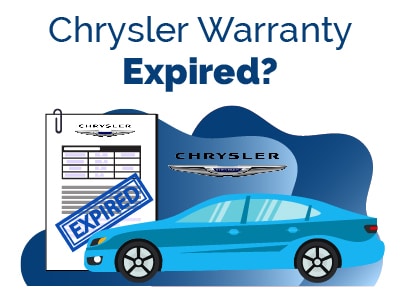
As your Chrysler factory warranty nears its expiration, you should determine what your next steps will be. You can choose to keep the vehicle without a warranty, purchase the Chrysler extended warranty, or purchase a third-party extended warranty.
Note that you can only purchase the Chrysler extended warranty before your factory coverage expires. Starting the planning ahead of time is critical for this. Here’s an outline of the steps to take:
- Begin planning 3 months/ 3,000 miles before the end of your basic warranty.
- Determine if an extended warranty makes sense for you based on your car ownership plans and financial situation.
- Contact your Chrysler dealership for an extended warranty quote.
- Request quotes from third-party providers.
- Compare the plans and choose the best one for your needs and budget.
- Should you decide on the Chrysler vehicle service agreement, you must set it up before your factory warranty ends. If you choose a third-party provider, you can get coverage at any time.
What Is the Chrysler Extended Warranty?
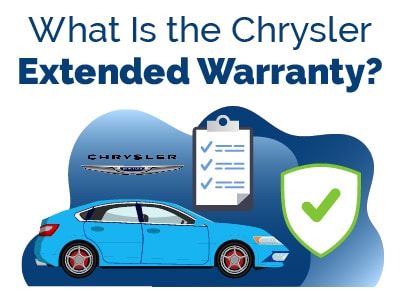 Chrysler offers extended warranty options (or a vehicle service contract) that you can purchase to cover your vehicle after your factory warranty expires. Their extended warranties are managed by Mopar.
Chrysler offers extended warranty options (or a vehicle service contract) that you can purchase to cover your vehicle after your factory warranty expires. Their extended warranties are managed by Mopar.
Maximum Care
Maximum Care is the most comprehensive Chrysler extended warranty. It covers over 5,000 components and offers several term lengths and conditions to choose from. You can choose between a $0, $100, and $200 deductible for coverage that lasts up to 8 years/125,000 miles. This plan also includes several additional benefits that we’ll review later.
Added Care Plus
Added Care Plus extends powertrain coverage and coverage on 800 major parts. This coverage is available for new or used vehicles. Term options range from 60,000 miles to 150,000 miles, and deductibles range from $0 to $200.
Powertrain Care
Powertrain Care is Chrysler’s basic protection plan. This extended coverage includes your engine, transmission, and driveline as well as 300 total components.
Chrysler Additional Protection Plans
Aside from the extended warranties, there are additional plans you can add for greater coverage. These plans include:
Road Hazard Tire & Wheel Protection
Purchase Road Hazard Tire & Wheel Protection any time for coverage terms of 1 to 7 years. You can get up to $7,500 of repair and replacement costs for the life of the tires/wheels. With this plan, you also get $100 of towing/roadside assistance credit and a $0 deductible per visit.
GAP Coverage
Chrysler also offers GAP (guaranteed asset protection) insurance that will pay the remainder of what you owe on the vehicle if it is totaled or stolen. This can ensure you do not end up upside-down in a car loan.
Auto Appearance
Protect your vehicle’s aesthetics with Auto Apperance. It covers dings and ents on the exterior metal panels using Paintless Dent Repair. It also covers windshield repair, carpet/mats, and upholstery for vehicles that are less than 11 years old with fewer than 80,000 miles.
MultiCare
MultiCare is a combination of the other plan above. It includes:
- Cosmetic wheel coverage
- Curb damage coverage
- Paintless dent repair
- Windshield repair
- Key replacement
- Roadside assistance
- Several interior and exterior repairs
- Car wash damage
- Construction damage
Note that you can choose coverage for up to 7 years, but it is not available in all states.
Chrysler Warranty Additional Benefits
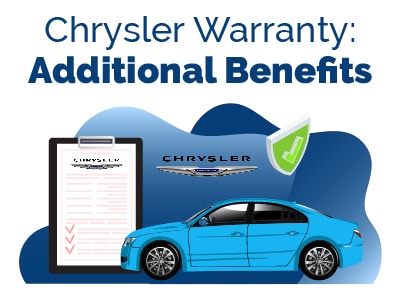 All extended warranties from Chrysler include:
All extended warranties from Chrysler include:
Roadside Assistance
Get up to a $100 reimbursement for typical roadside assistance situations, including battery jumps, fuel delivery, flat tires, and towing.
Rental Car Reimbursement
If you must use a rental car due to a breakdown, you can get up to $35 per day for up to $175 total per occurrence.
Trip Interruption Coverage
If you experience a breakdown over 100 miles from home, receive up to $1,000 for meals and lodging.
Protect Your Chrysler Lease
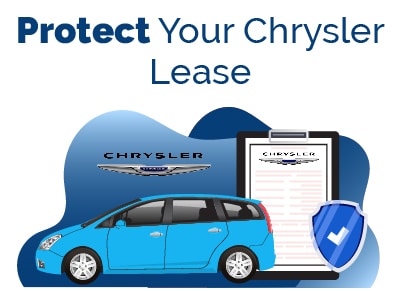 In addition to extended warranties, Chrysler offers options for protecting your lease. Some of their lease protection options include:
In addition to extended warranties, Chrysler offers options for protecting your lease. Some of their lease protection options include:
Lease Wear and Tear
Protect your lease against excess wear and tear for up to $5,000. This coverage includes several interior and exterior components, including:
- Upholstery
- Surface dents
- Audio equipment
- Tire wear
Lease Protect
Lease Protect helps you keep your vehicle looking its best during your least. Repair dents and dings with Paintless Dent Repair, and cover windshield cracks. It also covers your carpeting/floor mats, seats, and tire/rims.
Platinum Lease
The Platinum Lease plan also includes Maximum Care mechanical protection and the same additional benefits as the Chrysler extended warranties (key fob repair, towing, roadside assistance, retinal car reimbursement). You can select the terms that suit your lease.
How Much Does Chrysler Extended Warranty Cost?
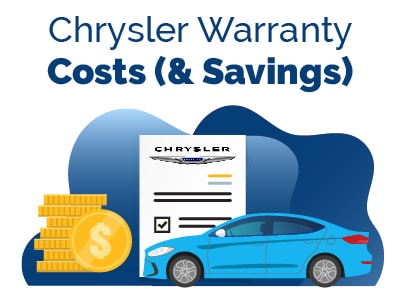
The cost of your Chrysler extended warranty will vary depending on the details of your plan. In general, Mopar warranties cost anywhere between $1,800 and $4,000. According to some quotes posted online, the total cost tends to be on the low end of the spectrum compared to other plans.
RepairPal estimates the average repair cost for Chrysler vehicles is $608 per year, which is fairly close to the industry average of $652. Here is a list of repair costs:
- $650 to $700 for window regulator replacement
- $500 to $2,200 for a suspension shock or strut replacement
- $600 to $700 for alternator replacement
- $700 to $800 for active suspension system control module replacement
What Is Not Covered by Chrysler Extended Warranty?
Much like any extended warranty, the Chrysler extended warranties do not cover a handful of components or situations, including:
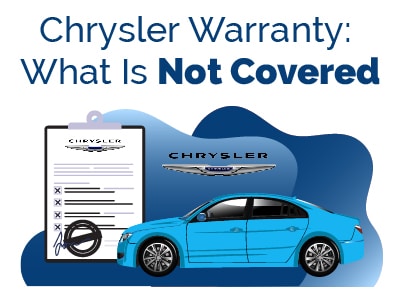 Body and paint items
Body and paint items- Maintenance services
- Brake rotors and drums
- Glass
- Plastic lenses
- Lightbulbs
- Trailer hitches
- Tires and wheels
- Accident damage
- Weather damage
- Damage from lack of maintenance
Should I Get the Chrysler Extended Warranty?
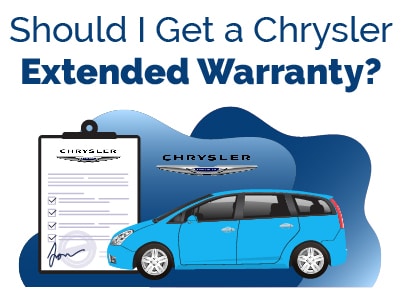
The reliability of any automaker can vary drastically based on the specific model at hand. Overall, the brand has improved its reliability over the last few years. In terms of reliability, common Chrysler vehicles rank 3.5 out of 5 stars by RepairPal.
Despite being around average for reliability, Chrysler vehicles can still undergo the same flukes as other makers. An extended warranty can help protect you from costly unexpected repairs, giving you greater peace of mind and flexibility with your savings.
However, an extended warranty is not necessary or ideal for everyone. Those with large savings or who plan to sell the vehicle shortly may not want one. Assess your vehicle ownership plans, monthly budget, and savings to determine if you’d rather pay for repairs out of pocket when they arise or pay for a warranty.
When it comes to extended warranties, the manufacturer-backed option is usually a strong option. If you determine that an extended warranty is best for you, then you should compare the plans and prices of several providers.
Chrysler Extended Warranty vs. Third-Party Extended Warranty
If you're looking for an extended warranty, there are plenty of third-party options to consider outside of the manufacturer.
Endurance [Review], CarEdge [Review], and Olive.com [Review] also offer extended warranties.
| Chrysler | Endurance | CarEdge | Olive.com | |
| Start Date | ||||
| Availability | ||||
| Max Coverage Length | ||||
| Plan Options | ||||
| Transferable? | ||||
| Deductible | ||||
| Repair Network | ||||
| Cancellation |
Can I Cancel Chrysler Warranty?
Yes, you can cancel a Chrysler extended warranty. You should contact your dealer to request termination.
As with all Mopar warranties, you can cancel within the first 60 days for a full refund if you did not yet use coverage from your plan. After 60 days, you can request a prorated refund.
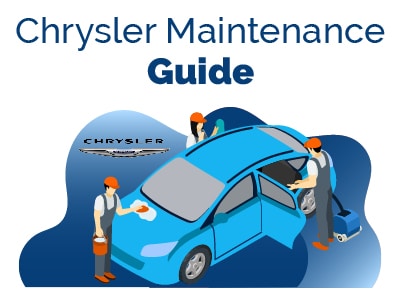 Chrysler Maintenance Guide
Chrysler Maintenance Guide
Chrysler warranties do not cover maintenance. However, keeping up with maintenance is important for keeping your vehicle in good condition. Problems due to lack of maintenance are not covered under warranty.
Therefore, you should follow Chrysler’s maintenance guide. Keep records of your maintenance and vehicle service, as it may be required for any claims.
You should inquire about the maintenance guide for your specific vehicle. In general, Chrysler recommends the following:
- Every 8,000 miles/6 months: Oil and filter change, tire rotation.
- Every 16,000 miles/ 12 months: Inspect and replace, if necessary, the engine air filter, brake lining, AC filter, exhaust system, and front suspension.
- Every 24,000 miles/18 months: Inspect/repace the CV joints and exhaust system
Best Car Deals by Category
Frequently Asked Questions
How long does the basic Chrysler warranty last?
Chrysler’s basic factory warranty lasts for 3 years/36,000 miles.
How long does the Chrysler extended warranty last?
The longest Chrysler extended warranty term lasts up to 8 years/125,000 miles. However, you can opt for shorter-term lengths as well.
Does Chrysler's extended warranty cover maintenance?
No, Chrysler extended warranties do not cover maintenance. However, lack of maintenance can cause issues that the warranty won’t cover, so be sure to follow the proper maintenance schedule for your vehicle.
Is the Chrysler extended warranty worth it?
For some car owners, the Chrysler extended warranty may be worth it. An extended warranty gives you peace of mind and can be worth it when you consider the cost of expensive repairs. However, even if an extended warranty is for you, you should compare the quotes from several providers before choosing.
Can I transfer my Chrysler extended warranty?
Yes, you can transfer your Chrysler extended warranty for $50.
Are Chrysler cars expensive to repair?
Chrysler vehicles have an annual repair cost of $608, close to the industry average of $652. The cost for a specific repair can vary dramatically depending on the specific part and damage. Therefore, parts like engines and transmissions can cost thousands of dollars to repair.
Where can I take my Chrysler for repairs under warranty?
Under your Chrysler warranty, you can bring your vehicle to a Chrysler dealership for repair.
Can I extend my Chrysler warranty after it expires?
You can purchase an extended warranty to start after your Chrysler factory warranty expires, but you must do so while your vehicle is still under warranty.
Posted in Car Buying Tips, Car Warranty |
- Car Extended Warranty Guide
- Different Types of Car Warranties
- What's the Deal with Extended Warranties in California?
- Hybrid & EV Battery Warrranty Guide
- Best Warranty Provider Comparison
- Calculate Extended Warranty Cost
- What Can Void a Car Warranty?
- Interesting Car Warranty Statistics
- How to Stop Car Warranty Calls

